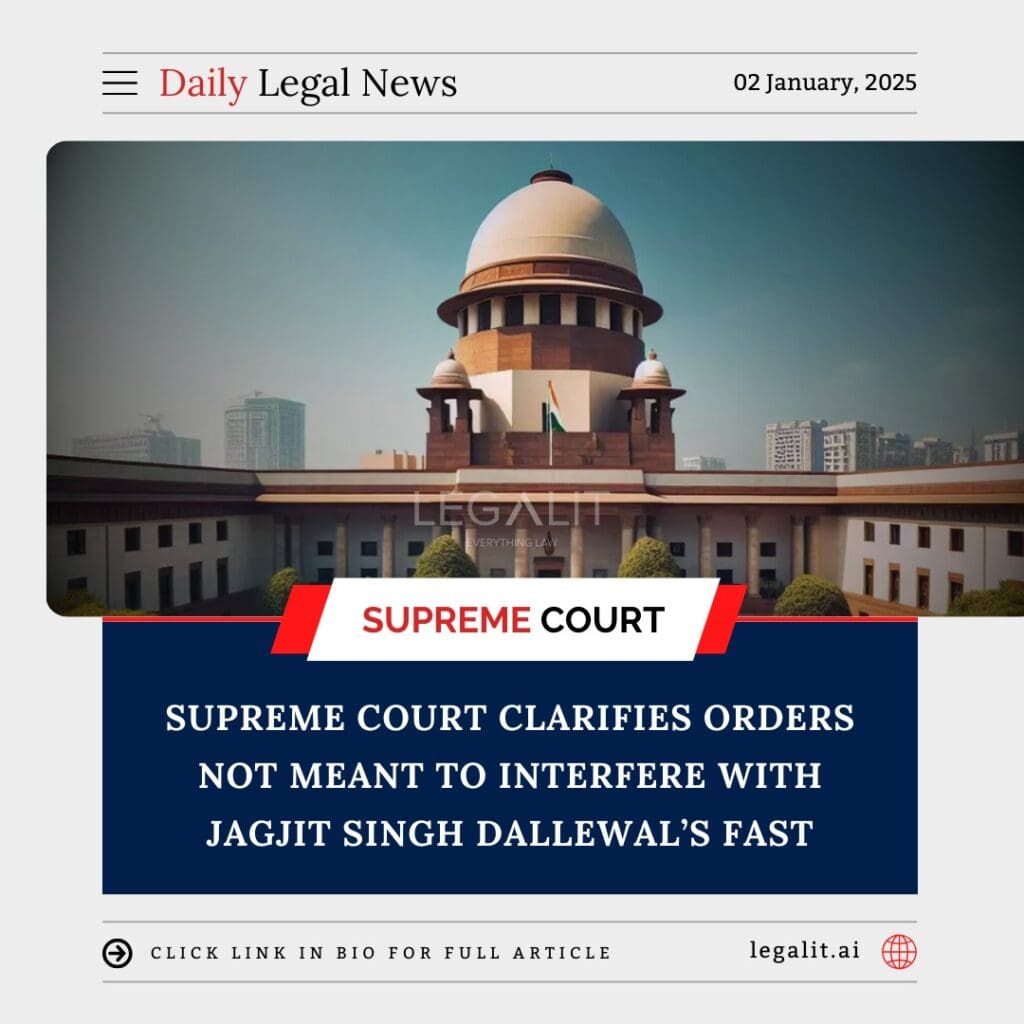
In a recent ruling, the Supreme Court of India clarified that its orders were not intended to interfere with the ongoing fast of farmer leader Jagjit Singh Dallewal, who has been protesting for the protection of agricultural rights and related issues. The Court emphasized that the intent behind its intervention was not to disrupt the fast but to ensure the welfare of the individual in the midst of the ongoing protest.
1. Context of the Protest and Fast
Jagjit Singh Dallewal, a prominent leader of the farmers’ movement, has been on a hunger strike as part of his protest demanding government action on various issues related to agriculture. The fast, which has drawn significant attention, is aimed at pressuring the government to address the concerns of farmers, including legal guarantees for minimum support prices and the repeal of laws they argue are unfavorable to their interests.
Dallewal’s fast has garnered widespread support, and many farmers have rallied around his cause. However, concerns about his health were raised when the fast extended over several days without medical intervention.
2. Supreme Court’s Intervention
The Supreme Court stepped in after reports surfaced that Dallewal’s health was deteriorating due to the prolonged fast. The Court directed the concerned authorities to provide medical assistance to him. However, the Court made it clear that its orders were not meant to forcefully end the fast or intervene with the peaceful nature of the protest.
The Court reiterated that it recognizes the right of individuals to engage in peaceful protests, including fasting as a form of non-violent expression. However, it also stressed the importance of safeguarding public health and ensuring that the protest does not lead to irreversible harm.
3. Clarification from the Bench
A bench of the Supreme Court, while passing the order, stated that the intervention was purely for the purpose of ensuring the well-being of Dallewal and to ensure that his life was not endangered. The Court further emphasized that the ruling was not meant to break his fast or stop his protest but to provide necessary medical assistance if required.
This clarification came after some confusion over the intent behind the Court’s direction, with various media outlets and observers interpreting the order as an attempt to end the protest. The Supreme Court’s statement aimed to quell any such misconceptions and reassure the public of the Court’s respect for the right to protest.
4. Response from Dallewal and Supporters
Jagjit Singh Dallewal, in response to the Supreme Court’s order, reiterated his commitment to continue with the fast until his demands were met. He made it clear that his protest was non-violent and aimed solely at highlighting the issues faced by farmers.
His supporters, including several farmer unions, have expressed gratitude towards the Court for taking cognizance of the matter and ensuring that Dallewal’s health would be closely monitored. They have also clarified that the protest will continue peacefully until their demands are addressed by the government.
5. Legal and Political Implications
The Supreme Court’s involvement in this case highlights the balance between the right to protest and the duty of the state to ensure public health and safety. The Court’s stance reflects a nuanced approach to the right to protest, particularly in cases where public figures engage in protests that may risk their well-being.
This intervention has the potential to set a precedent for future cases involving public protests, particularly those that involve hunger strikes or similar forms of protest. Legal experts have noted that the ruling could shape how the judiciary deals with cases where an individual’s right to protest may conflict with concerns over public health.
Conclusion
The Supreme Court’s clarification regarding its orders in the case of Jagjit Singh Dallewal’s fast underlines its commitment to ensuring public welfare while also upholding the rights of individuals to protest. The Court’s intervention is seen as a reminder of the delicate balance between ensuring the safety of individuals involved in protests and respecting their constitutional rights to engage in non-violent demonstrations. As Dallewal’s fast continues, the focus now shifts to the government’s response to the demands raised by the protest.